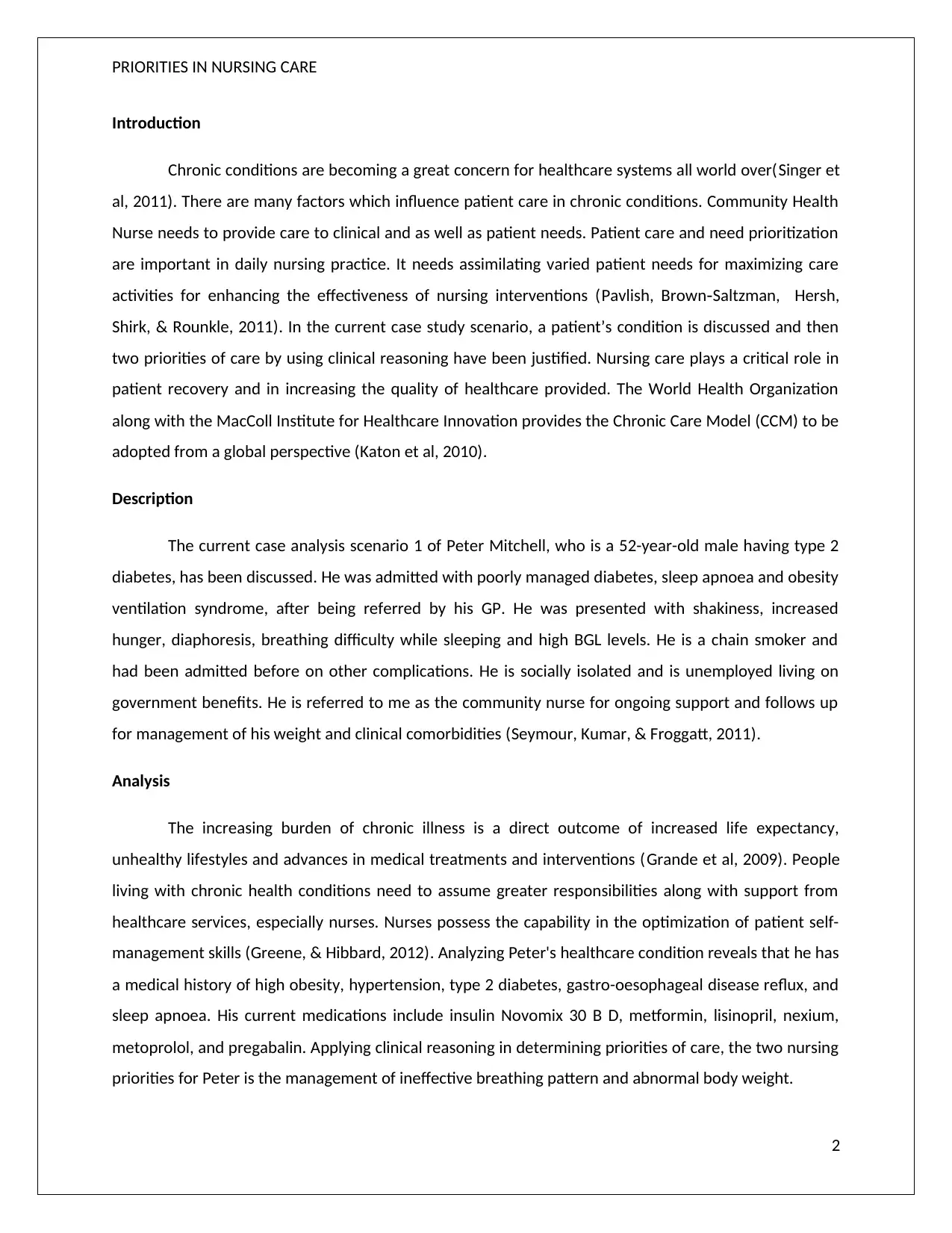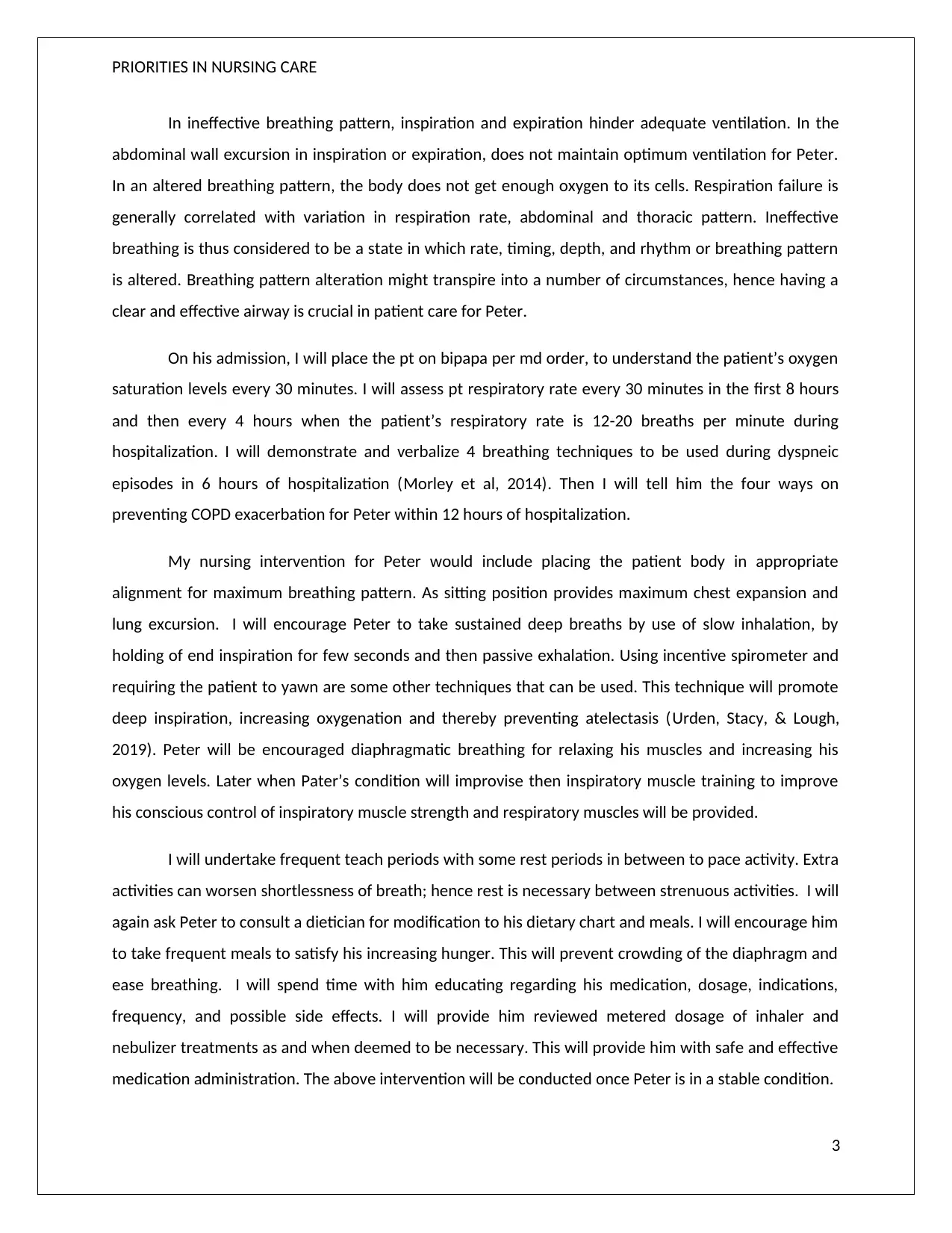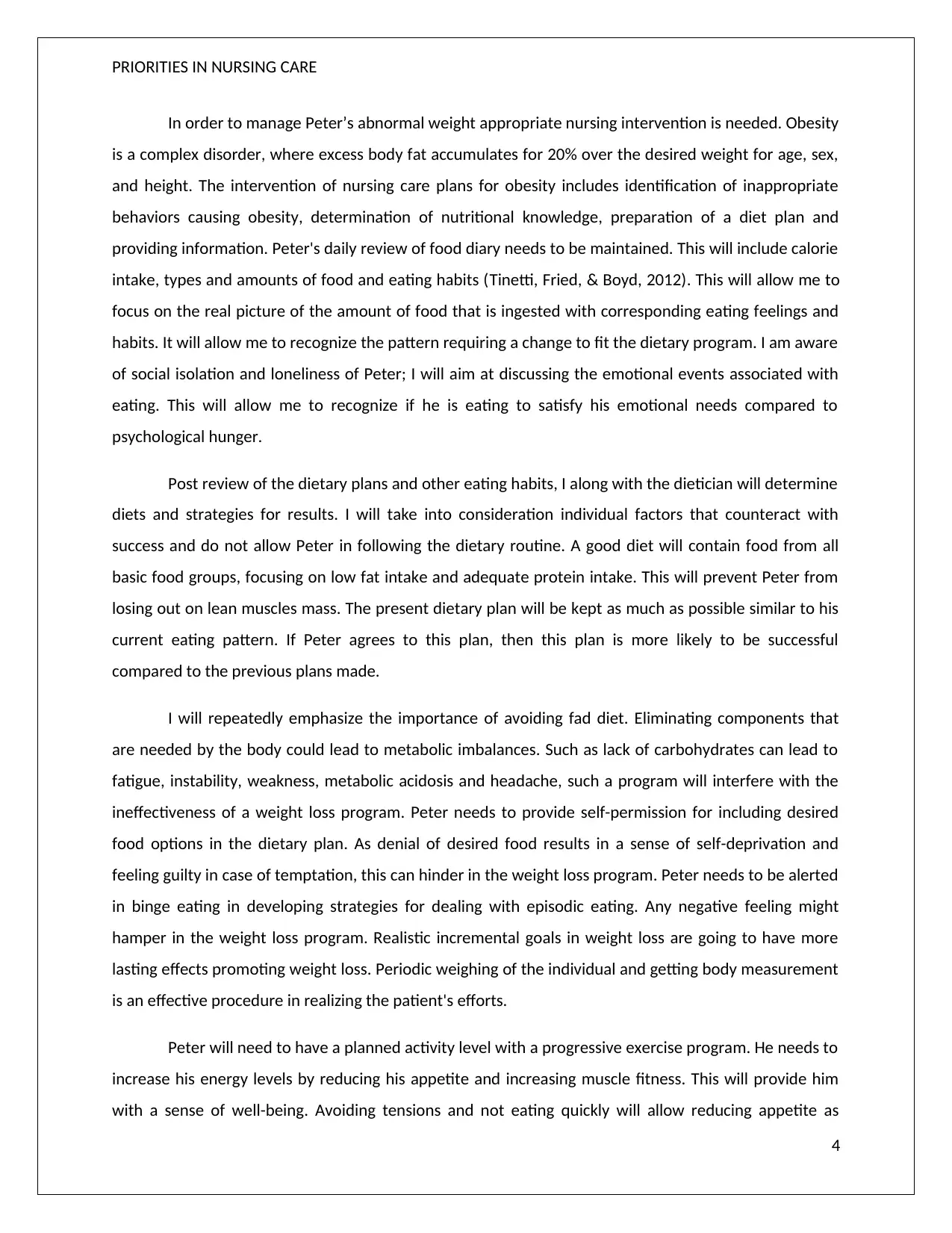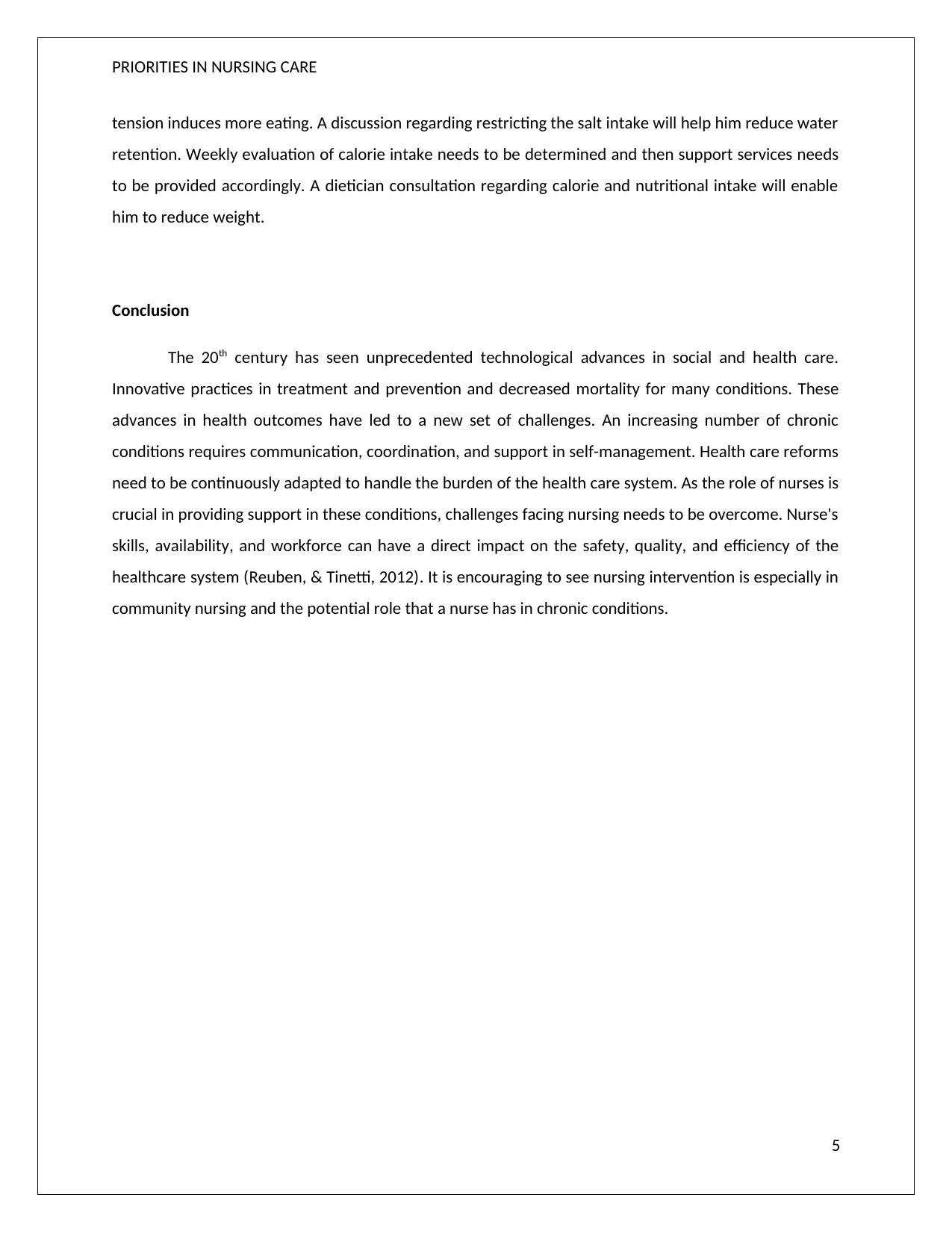Priorities in Nursing Care
VerifiedAdded on 2023/01/16
|7
|2376
|40
AI Summary
This article discusses the priorities in nursing care for patients with chronic conditions, focusing on managing breathing patterns and abnormal body weight. It emphasizes the role of nurses in patient recovery and improving healthcare quality.
Contribute Materials
Your contribution can guide someone’s learning journey. Share your
documents today.

Running Head: PRIORITIES IN NURSING CARE
PRIORITIES IN NURSING CASE CARE
PRIORITIES IN NURSING CASE CARE
Secure Best Marks with AI Grader
Need help grading? Try our AI Grader for instant feedback on your assignments.

PRIORITIES IN NURSING CARE
Introduction
Chronic conditions are becoming a great concern for healthcare systems all world over(Singer et
al, 2011). There are many factors which influence patient care in chronic conditions. Community Health
Nurse needs to provide care to clinical and as well as patient needs. Patient care and need prioritization
are important in daily nursing practice. It needs assimilating varied patient needs for maximizing care
activities for enhancing the effectiveness of nursing interventions (Pavlish, Brown Saltzman, Hersh,‐
Shirk, & Rounkle, 2011). In the current case study scenario, a patient’s condition is discussed and then
two priorities of care by using clinical reasoning have been justified. Nursing care plays a critical role in
patient recovery and in increasing the quality of healthcare provided. The World Health Organization
along with the MacColl Institute for Healthcare Innovation provides the Chronic Care Model (CCM) to be
adopted from a global perspective (Katon et al, 2010).
Description
The current case analysis scenario 1 of Peter Mitchell, who is a 52-year-old male having type 2
diabetes, has been discussed. He was admitted with poorly managed diabetes, sleep apnoea and obesity
ventilation syndrome, after being referred by his GP. He was presented with shakiness, increased
hunger, diaphoresis, breathing difficulty while sleeping and high BGL levels. He is a chain smoker and
had been admitted before on other complications. He is socially isolated and is unemployed living on
government benefits. He is referred to me as the community nurse for ongoing support and follows up
for management of his weight and clinical comorbidities (Seymour, Kumar, & Froggatt, 2011).
Analysis
The increasing burden of chronic illness is a direct outcome of increased life expectancy,
unhealthy lifestyles and advances in medical treatments and interventions (Grande et al, 2009). People
living with chronic health conditions need to assume greater responsibilities along with support from
healthcare services, especially nurses. Nurses possess the capability in the optimization of patient self-
management skills (Greene, & Hibbard, 2012). Analyzing Peter's healthcare condition reveals that he has
a medical history of high obesity, hypertension, type 2 diabetes, gastro-oesophageal disease reflux, and
sleep apnoea. His current medications include insulin Novomix 30 B D, metformin, lisinopril, nexium,
metoprolol, and pregabalin. Applying clinical reasoning in determining priorities of care, the two nursing
priorities for Peter is the management of ineffective breathing pattern and abnormal body weight.
2
Introduction
Chronic conditions are becoming a great concern for healthcare systems all world over(Singer et
al, 2011). There are many factors which influence patient care in chronic conditions. Community Health
Nurse needs to provide care to clinical and as well as patient needs. Patient care and need prioritization
are important in daily nursing practice. It needs assimilating varied patient needs for maximizing care
activities for enhancing the effectiveness of nursing interventions (Pavlish, Brown Saltzman, Hersh,‐
Shirk, & Rounkle, 2011). In the current case study scenario, a patient’s condition is discussed and then
two priorities of care by using clinical reasoning have been justified. Nursing care plays a critical role in
patient recovery and in increasing the quality of healthcare provided. The World Health Organization
along with the MacColl Institute for Healthcare Innovation provides the Chronic Care Model (CCM) to be
adopted from a global perspective (Katon et al, 2010).
Description
The current case analysis scenario 1 of Peter Mitchell, who is a 52-year-old male having type 2
diabetes, has been discussed. He was admitted with poorly managed diabetes, sleep apnoea and obesity
ventilation syndrome, after being referred by his GP. He was presented with shakiness, increased
hunger, diaphoresis, breathing difficulty while sleeping and high BGL levels. He is a chain smoker and
had been admitted before on other complications. He is socially isolated and is unemployed living on
government benefits. He is referred to me as the community nurse for ongoing support and follows up
for management of his weight and clinical comorbidities (Seymour, Kumar, & Froggatt, 2011).
Analysis
The increasing burden of chronic illness is a direct outcome of increased life expectancy,
unhealthy lifestyles and advances in medical treatments and interventions (Grande et al, 2009). People
living with chronic health conditions need to assume greater responsibilities along with support from
healthcare services, especially nurses. Nurses possess the capability in the optimization of patient self-
management skills (Greene, & Hibbard, 2012). Analyzing Peter's healthcare condition reveals that he has
a medical history of high obesity, hypertension, type 2 diabetes, gastro-oesophageal disease reflux, and
sleep apnoea. His current medications include insulin Novomix 30 B D, metformin, lisinopril, nexium,
metoprolol, and pregabalin. Applying clinical reasoning in determining priorities of care, the two nursing
priorities for Peter is the management of ineffective breathing pattern and abnormal body weight.
2

PRIORITIES IN NURSING CARE
In ineffective breathing pattern, inspiration and expiration hinder adequate ventilation. In the
abdominal wall excursion in inspiration or expiration, does not maintain optimum ventilation for Peter.
In an altered breathing pattern, the body does not get enough oxygen to its cells. Respiration failure is
generally correlated with variation in respiration rate, abdominal and thoracic pattern. Ineffective
breathing is thus considered to be a state in which rate, timing, depth, and rhythm or breathing pattern
is altered. Breathing pattern alteration might transpire into a number of circumstances, hence having a
clear and effective airway is crucial in patient care for Peter.
On his admission, I will place the pt on bipapa per md order, to understand the patient’s oxygen
saturation levels every 30 minutes. I will assess pt respiratory rate every 30 minutes in the first 8 hours
and then every 4 hours when the patient’s respiratory rate is 12-20 breaths per minute during
hospitalization. I will demonstrate and verbalize 4 breathing techniques to be used during dyspneic
episodes in 6 hours of hospitalization (Morley et al, 2014). Then I will tell him the four ways on
preventing COPD exacerbation for Peter within 12 hours of hospitalization.
My nursing intervention for Peter would include placing the patient body in appropriate
alignment for maximum breathing pattern. As sitting position provides maximum chest expansion and
lung excursion. I will encourage Peter to take sustained deep breaths by use of slow inhalation, by
holding of end inspiration for few seconds and then passive exhalation. Using incentive spirometer and
requiring the patient to yawn are some other techniques that can be used. This technique will promote
deep inspiration, increasing oxygenation and thereby preventing atelectasis (Urden, Stacy, & Lough,
2019). Peter will be encouraged diaphragmatic breathing for relaxing his muscles and increasing his
oxygen levels. Later when Pater’s condition will improvise then inspiratory muscle training to improve
his conscious control of inspiratory muscle strength and respiratory muscles will be provided.
I will undertake frequent teach periods with some rest periods in between to pace activity. Extra
activities can worsen shortlessness of breath; hence rest is necessary between strenuous activities. I will
again ask Peter to consult a dietician for modification to his dietary chart and meals. I will encourage him
to take frequent meals to satisfy his increasing hunger. This will prevent crowding of the diaphragm and
ease breathing. I will spend time with him educating regarding his medication, dosage, indications,
frequency, and possible side effects. I will provide him reviewed metered dosage of inhaler and
nebulizer treatments as and when deemed to be necessary. This will provide him with safe and effective
medication administration. The above intervention will be conducted once Peter is in a stable condition.
3
In ineffective breathing pattern, inspiration and expiration hinder adequate ventilation. In the
abdominal wall excursion in inspiration or expiration, does not maintain optimum ventilation for Peter.
In an altered breathing pattern, the body does not get enough oxygen to its cells. Respiration failure is
generally correlated with variation in respiration rate, abdominal and thoracic pattern. Ineffective
breathing is thus considered to be a state in which rate, timing, depth, and rhythm or breathing pattern
is altered. Breathing pattern alteration might transpire into a number of circumstances, hence having a
clear and effective airway is crucial in patient care for Peter.
On his admission, I will place the pt on bipapa per md order, to understand the patient’s oxygen
saturation levels every 30 minutes. I will assess pt respiratory rate every 30 minutes in the first 8 hours
and then every 4 hours when the patient’s respiratory rate is 12-20 breaths per minute during
hospitalization. I will demonstrate and verbalize 4 breathing techniques to be used during dyspneic
episodes in 6 hours of hospitalization (Morley et al, 2014). Then I will tell him the four ways on
preventing COPD exacerbation for Peter within 12 hours of hospitalization.
My nursing intervention for Peter would include placing the patient body in appropriate
alignment for maximum breathing pattern. As sitting position provides maximum chest expansion and
lung excursion. I will encourage Peter to take sustained deep breaths by use of slow inhalation, by
holding of end inspiration for few seconds and then passive exhalation. Using incentive spirometer and
requiring the patient to yawn are some other techniques that can be used. This technique will promote
deep inspiration, increasing oxygenation and thereby preventing atelectasis (Urden, Stacy, & Lough,
2019). Peter will be encouraged diaphragmatic breathing for relaxing his muscles and increasing his
oxygen levels. Later when Pater’s condition will improvise then inspiratory muscle training to improve
his conscious control of inspiratory muscle strength and respiratory muscles will be provided.
I will undertake frequent teach periods with some rest periods in between to pace activity. Extra
activities can worsen shortlessness of breath; hence rest is necessary between strenuous activities. I will
again ask Peter to consult a dietician for modification to his dietary chart and meals. I will encourage him
to take frequent meals to satisfy his increasing hunger. This will prevent crowding of the diaphragm and
ease breathing. I will spend time with him educating regarding his medication, dosage, indications,
frequency, and possible side effects. I will provide him reviewed metered dosage of inhaler and
nebulizer treatments as and when deemed to be necessary. This will provide him with safe and effective
medication administration. The above intervention will be conducted once Peter is in a stable condition.
3

PRIORITIES IN NURSING CARE
In order to manage Peter’s abnormal weight appropriate nursing intervention is needed. Obesity
is a complex disorder, where excess body fat accumulates for 20% over the desired weight for age, sex,
and height. The intervention of nursing care plans for obesity includes identification of inappropriate
behaviors causing obesity, determination of nutritional knowledge, preparation of a diet plan and
providing information. Peter's daily review of food diary needs to be maintained. This will include calorie
intake, types and amounts of food and eating habits (Tinetti, Fried, & Boyd, 2012). This will allow me to
focus on the real picture of the amount of food that is ingested with corresponding eating feelings and
habits. It will allow me to recognize the pattern requiring a change to fit the dietary program. I am aware
of social isolation and loneliness of Peter; I will aim at discussing the emotional events associated with
eating. This will allow me to recognize if he is eating to satisfy his emotional needs compared to
psychological hunger.
Post review of the dietary plans and other eating habits, I along with the dietician will determine
diets and strategies for results. I will take into consideration individual factors that counteract with
success and do not allow Peter in following the dietary routine. A good diet will contain food from all
basic food groups, focusing on low fat intake and adequate protein intake. This will prevent Peter from
losing out on lean muscles mass. The present dietary plan will be kept as much as possible similar to his
current eating pattern. If Peter agrees to this plan, then this plan is more likely to be successful
compared to the previous plans made.
I will repeatedly emphasize the importance of avoiding fad diet. Eliminating components that
are needed by the body could lead to metabolic imbalances. Such as lack of carbohydrates can lead to
fatigue, instability, weakness, metabolic acidosis and headache, such a program will interfere with the
ineffectiveness of a weight loss program. Peter needs to provide self-permission for including desired
food options in the dietary plan. As denial of desired food results in a sense of self-deprivation and
feeling guilty in case of temptation, this can hinder in the weight loss program. Peter needs to be alerted
in binge eating in developing strategies for dealing with episodic eating. Any negative feeling might
hamper in the weight loss program. Realistic incremental goals in weight loss are going to have more
lasting effects promoting weight loss. Periodic weighing of the individual and getting body measurement
is an effective procedure in realizing the patient's efforts.
Peter will need to have a planned activity level with a progressive exercise program. He needs to
increase his energy levels by reducing his appetite and increasing muscle fitness. This will provide him
with a sense of well-being. Avoiding tensions and not eating quickly will allow reducing appetite as
4
In order to manage Peter’s abnormal weight appropriate nursing intervention is needed. Obesity
is a complex disorder, where excess body fat accumulates for 20% over the desired weight for age, sex,
and height. The intervention of nursing care plans for obesity includes identification of inappropriate
behaviors causing obesity, determination of nutritional knowledge, preparation of a diet plan and
providing information. Peter's daily review of food diary needs to be maintained. This will include calorie
intake, types and amounts of food and eating habits (Tinetti, Fried, & Boyd, 2012). This will allow me to
focus on the real picture of the amount of food that is ingested with corresponding eating feelings and
habits. It will allow me to recognize the pattern requiring a change to fit the dietary program. I am aware
of social isolation and loneliness of Peter; I will aim at discussing the emotional events associated with
eating. This will allow me to recognize if he is eating to satisfy his emotional needs compared to
psychological hunger.
Post review of the dietary plans and other eating habits, I along with the dietician will determine
diets and strategies for results. I will take into consideration individual factors that counteract with
success and do not allow Peter in following the dietary routine. A good diet will contain food from all
basic food groups, focusing on low fat intake and adequate protein intake. This will prevent Peter from
losing out on lean muscles mass. The present dietary plan will be kept as much as possible similar to his
current eating pattern. If Peter agrees to this plan, then this plan is more likely to be successful
compared to the previous plans made.
I will repeatedly emphasize the importance of avoiding fad diet. Eliminating components that
are needed by the body could lead to metabolic imbalances. Such as lack of carbohydrates can lead to
fatigue, instability, weakness, metabolic acidosis and headache, such a program will interfere with the
ineffectiveness of a weight loss program. Peter needs to provide self-permission for including desired
food options in the dietary plan. As denial of desired food results in a sense of self-deprivation and
feeling guilty in case of temptation, this can hinder in the weight loss program. Peter needs to be alerted
in binge eating in developing strategies for dealing with episodic eating. Any negative feeling might
hamper in the weight loss program. Realistic incremental goals in weight loss are going to have more
lasting effects promoting weight loss. Periodic weighing of the individual and getting body measurement
is an effective procedure in realizing the patient's efforts.
Peter will need to have a planned activity level with a progressive exercise program. He needs to
increase his energy levels by reducing his appetite and increasing muscle fitness. This will provide him
with a sense of well-being. Avoiding tensions and not eating quickly will allow reducing appetite as
4
Secure Best Marks with AI Grader
Need help grading? Try our AI Grader for instant feedback on your assignments.

PRIORITIES IN NURSING CARE
tension induces more eating. A discussion regarding restricting the salt intake will help him reduce water
retention. Weekly evaluation of calorie intake needs to be determined and then support services needs
to be provided accordingly. A dietician consultation regarding calorie and nutritional intake will enable
him to reduce weight.
Conclusion
The 20th century has seen unprecedented technological advances in social and health care.
Innovative practices in treatment and prevention and decreased mortality for many conditions. These
advances in health outcomes have led to a new set of challenges. An increasing number of chronic
conditions requires communication, coordination, and support in self-management. Health care reforms
need to be continuously adapted to handle the burden of the health care system. As the role of nurses is
crucial in providing support in these conditions, challenges facing nursing needs to be overcome. Nurse's
skills, availability, and workforce can have a direct impact on the safety, quality, and efficiency of the
healthcare system (Reuben, & Tinetti, 2012). It is encouraging to see nursing intervention is especially in
community nursing and the potential role that a nurse has in chronic conditions.
5
tension induces more eating. A discussion regarding restricting the salt intake will help him reduce water
retention. Weekly evaluation of calorie intake needs to be determined and then support services needs
to be provided accordingly. A dietician consultation regarding calorie and nutritional intake will enable
him to reduce weight.
Conclusion
The 20th century has seen unprecedented technological advances in social and health care.
Innovative practices in treatment and prevention and decreased mortality for many conditions. These
advances in health outcomes have led to a new set of challenges. An increasing number of chronic
conditions requires communication, coordination, and support in self-management. Health care reforms
need to be continuously adapted to handle the burden of the health care system. As the role of nurses is
crucial in providing support in these conditions, challenges facing nursing needs to be overcome. Nurse's
skills, availability, and workforce can have a direct impact on the safety, quality, and efficiency of the
healthcare system (Reuben, & Tinetti, 2012). It is encouraging to see nursing intervention is especially in
community nursing and the potential role that a nurse has in chronic conditions.
5

PRIORITIES IN NURSING CARE
Reference
Grande, G., Stajduhar, K., Aoun, S., Toye, C., Funk, L., Addington-Hall, J., Payne, S. and Todd, C. (2009).
Supporting lay carers in end of life care: current gaps and future priorities. Palliative
Medicine, 23(4), 339-344. doi:10.1177/0269216309104875. Retrieved from
<https://journals.sagepub.com/doi/abs/10.1177/0269216309104875>
Greene, J., & Hibbard, J. H. (2012). Why does patient activation matter? An examination of the
relationships between patient activation and health-related outcomes. Journal of general
internal medicine, 27(5), 520-526. doi: 10.1007/s11606-011-1931-2. Retrieved from
<https://link.springer.com/article/10.1007/s11606-011-1931-2>
Katon, W.J., Lin, E.H., Von Korff, M., Ciechanowski, P., Ludman, E.J., Young, B., Peterson, D., Rutter, C.M.,
McGregor, M. and McCulloch, D. (2010). Collaborative care for patients with depression and
chronic illnesses. New England Journal of Medicine, 363(27), 2611-2620.
doi:10.1056/NEJMoa1003955. Retrieved from
<https://www.nejm.org/doi/full/10.1056/nejmoa1003955>
Morley, J.E., Caplan, G., Cesari, M., Dong, B., Flaherty, J.H., Grossberg, G.T., Holmerova, I., Katz, P.R.,
Koopmans, R., Little, M.O. and Martin, F. (2014). International survey of nursing home research
priorities. Journal of the American Medical Directors Association, 15(5), 309-312. doi:
10.1016/j.jamda.2014.03.003. Retrieved from
<https://www.sciencedirect.com/science/article/pii/S1525861014001236>
Pavlish, C., Brown Saltzman, K., Hersh, M., Shirk, M., & Rounkle, A. M. (2011). Nursing priorities, actions,‐
and regrets for ethical situations in clinical practice. Journal of Nursing Scholarship, 43(4), 385-
395. doi: 10.1111/j.1547-5069.2011.01422.x. Retrieved from
<https://sigmapubs.onlinelibrary.wiley.com/doi/abs/10.1111/j.1547-5069.2011.01422.x>
6
Reference
Grande, G., Stajduhar, K., Aoun, S., Toye, C., Funk, L., Addington-Hall, J., Payne, S. and Todd, C. (2009).
Supporting lay carers in end of life care: current gaps and future priorities. Palliative
Medicine, 23(4), 339-344. doi:10.1177/0269216309104875. Retrieved from
<https://journals.sagepub.com/doi/abs/10.1177/0269216309104875>
Greene, J., & Hibbard, J. H. (2012). Why does patient activation matter? An examination of the
relationships between patient activation and health-related outcomes. Journal of general
internal medicine, 27(5), 520-526. doi: 10.1007/s11606-011-1931-2. Retrieved from
<https://link.springer.com/article/10.1007/s11606-011-1931-2>
Katon, W.J., Lin, E.H., Von Korff, M., Ciechanowski, P., Ludman, E.J., Young, B., Peterson, D., Rutter, C.M.,
McGregor, M. and McCulloch, D. (2010). Collaborative care for patients with depression and
chronic illnesses. New England Journal of Medicine, 363(27), 2611-2620.
doi:10.1056/NEJMoa1003955. Retrieved from
<https://www.nejm.org/doi/full/10.1056/nejmoa1003955>
Morley, J.E., Caplan, G., Cesari, M., Dong, B., Flaherty, J.H., Grossberg, G.T., Holmerova, I., Katz, P.R.,
Koopmans, R., Little, M.O. and Martin, F. (2014). International survey of nursing home research
priorities. Journal of the American Medical Directors Association, 15(5), 309-312. doi:
10.1016/j.jamda.2014.03.003. Retrieved from
<https://www.sciencedirect.com/science/article/pii/S1525861014001236>
Pavlish, C., Brown Saltzman, K., Hersh, M., Shirk, M., & Rounkle, A. M. (2011). Nursing priorities, actions,‐
and regrets for ethical situations in clinical practice. Journal of Nursing Scholarship, 43(4), 385-
395. doi: 10.1111/j.1547-5069.2011.01422.x. Retrieved from
<https://sigmapubs.onlinelibrary.wiley.com/doi/abs/10.1111/j.1547-5069.2011.01422.x>
6

PRIORITIES IN NURSING CARE
Reuben, D. B., & Tinetti, M. E. (2012). Goal-oriented patient care—an alternative health outcomes
paradigm. New England Journal of Medicine, 366(9), 777-779. doi: 10.1056/NEJMp1113631.
Retrieved from <https://www.nejm.org/doi/full/10.1056/nejmp1113631>
Seymour, J. E., Kumar, A., & Froggatt, K. (2011). Do nursing homes for older people have the support
they need to provide end-of-life care? A mixed methods enquiry in England. Palliative
Medicine, 25(2), 125-138. doi: 10.1177/0269216310387964. Retrieved from
<https://journals.sagepub.com/doi/full/10.1177/0269216310387964>
Singer, S. J., Burgers, J., Friedberg, M., Rosenthal, M. B., Leape, L., & Schneider, E. (2011). Defining and
measuring integrated patient care: promoting the next frontier in health care delivery. Medical
Care Research and Review, 68(1), 112-127. doi: 10.1177/1077558710371485. Retrieved from
<https://journals.sagepub.com/doi/abs/10.1177/1077558710371485>
Tinetti, M. E., Fried, T. R., & Boyd, C. M. (2012). Designing health care for the most common chronic
condition—multimorbidity. Jama, 307(23), 2493-2494. doi: 10.1001/jama.2012.5265. Retrieved
from <https://jamanetwork.com/journals/jama/article-abstract/1187936>
Urden, L. D., Stacy, K. M., & Lough, M. E. (2019). Priorities in critical care nursing 8th Edition. Canada:
Elsevier Health Sciences. Retrieved from <https://books.google.co.in/books?
hl=en&lr=&id=jySDDwAAQBAJ&oi=fnd&pg=PP1&dq=nursing+priorities+of+care&ots=-
XLx2iM5Fz&sig=h9d45mpNaCm6A_dfw8KmaCbmRPw#v=onepage&q=nursing%20priorities
%20of%20care&f=false>
7
Reuben, D. B., & Tinetti, M. E. (2012). Goal-oriented patient care—an alternative health outcomes
paradigm. New England Journal of Medicine, 366(9), 777-779. doi: 10.1056/NEJMp1113631.
Retrieved from <https://www.nejm.org/doi/full/10.1056/nejmp1113631>
Seymour, J. E., Kumar, A., & Froggatt, K. (2011). Do nursing homes for older people have the support
they need to provide end-of-life care? A mixed methods enquiry in England. Palliative
Medicine, 25(2), 125-138. doi: 10.1177/0269216310387964. Retrieved from
<https://journals.sagepub.com/doi/full/10.1177/0269216310387964>
Singer, S. J., Burgers, J., Friedberg, M., Rosenthal, M. B., Leape, L., & Schneider, E. (2011). Defining and
measuring integrated patient care: promoting the next frontier in health care delivery. Medical
Care Research and Review, 68(1), 112-127. doi: 10.1177/1077558710371485. Retrieved from
<https://journals.sagepub.com/doi/abs/10.1177/1077558710371485>
Tinetti, M. E., Fried, T. R., & Boyd, C. M. (2012). Designing health care for the most common chronic
condition—multimorbidity. Jama, 307(23), 2493-2494. doi: 10.1001/jama.2012.5265. Retrieved
from <https://jamanetwork.com/journals/jama/article-abstract/1187936>
Urden, L. D., Stacy, K. M., & Lough, M. E. (2019). Priorities in critical care nursing 8th Edition. Canada:
Elsevier Health Sciences. Retrieved from <https://books.google.co.in/books?
hl=en&lr=&id=jySDDwAAQBAJ&oi=fnd&pg=PP1&dq=nursing+priorities+of+care&ots=-
XLx2iM5Fz&sig=h9d45mpNaCm6A_dfw8KmaCbmRPw#v=onepage&q=nursing%20priorities
%20of%20care&f=false>
7
1 out of 7
Related Documents
Your All-in-One AI-Powered Toolkit for Academic Success.
+13062052269
info@desklib.com
Available 24*7 on WhatsApp / Email
![[object Object]](/_next/static/media/star-bottom.7253800d.svg)
Unlock your academic potential
© 2024 | Zucol Services PVT LTD | All rights reserved.





